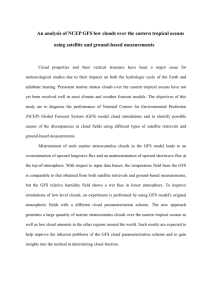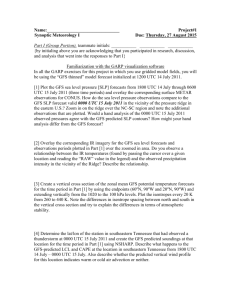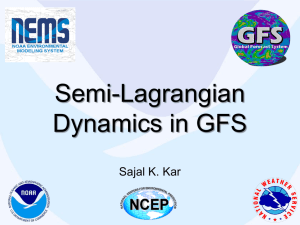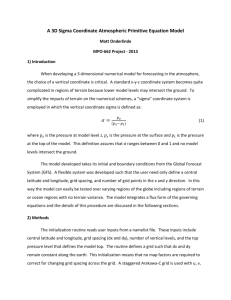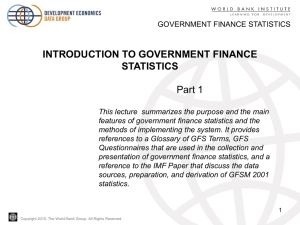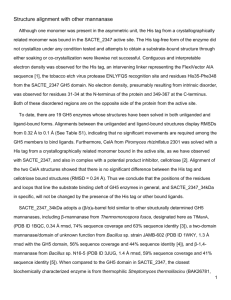Mohamed K Zobaa_Zobaa et al., 2011
advertisement
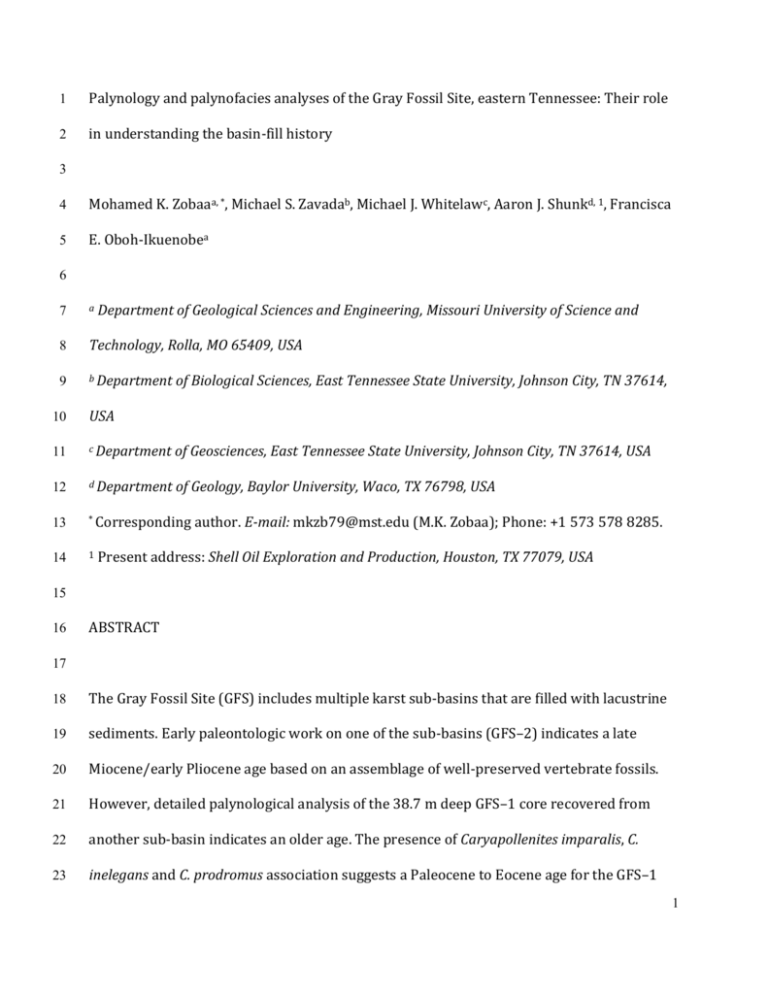
1 Palynology and palynofacies analyses of the Gray Fossil Site, eastern Tennessee: Their role 2 in understanding the basin-fill history 3 4 Mohamed K. Zobaaa, *, Michael S. Zavadab, Michael J. Whitelawc, Aaron J. Shunkd, 1, Francisca 5 E. Oboh-Ikuenobea 6 Department of Geological Sciences and Engineering, Missouri University of Science and 7 a 8 Technology, Rolla, MO 65409, USA 9 b Department of Biological Sciences, East Tennessee State University, Johnson City, TN 37614, 10 USA 11 c Department of Geosciences, East Tennessee State University, Johnson City, TN 37614, USA 12 d Department of Geology, Baylor University, Waco, TX 76798, USA 13 * Corresponding 14 1 author. E-mail: mkzb79@mst.edu (M.K. Zobaa); Phone: +1 573 578 8285. Present address: Shell Oil Exploration and Production, Houston, TX 77079, USA 15 16 ABSTRACT 17 18 The Gray Fossil Site (GFS) includes multiple karst sub-basins that are filled with lacustrine 19 sediments. Early paleontologic work on one of the sub-basins (GFS–2) indicates a late 20 Miocene/early Pliocene age based on an assemblage of well-preserved vertebrate fossils. 21 However, detailed palynological analysis of the 38.7 m deep GFS–1 core recovered from 22 another sub-basin indicates an older age. The presence of Caryapollenites imparalis, C. 23 inelegans and C. prodromus association suggests a Paleocene to Eocene age for the GFS–1 1 24 core section. This age is also supported by the absence of pollen of the Poaceae, the grass 25 family that is not commonly present until the Neogene. Age constraints from palynologic 26 data suggest that the GFS has a more complex basin-fill history than previously suspected, 27 and that multiple depo-centers within the basin may have been periodically active through 28 the Cenozoic. Palynofacies analysis of the GFS–1 core indicates that phytoclasts and 29 opaques are the most abundant organic constituents and have diluted both the 30 palynomorph population and amorphous organic matter. Two possible scenarios can 31 account for this observation: 1) an oxidizing depositional paleoenvironment; and 2) a 32 localized high flux of charcoal following wildfires and subsequent increased runoff. 33 34 Keywords: Gray; Paleocene; Eocene; palynology; palynofacies; geochemical analyses 35 36 1. Introduction 37 38 The Gray Fossil Site (GFS) is located in Washington County, northeast Tennessee (Fig. 39 1). The site was discovered in 2000 by the Tennessee Department of Transportation during 40 a road improvement project. Early auger coring completed at the GFS encountered a 41 complex bedrock geometry, which included multiple deep sub-basins separated by elevated 42 bedrock blocks (Clark et al., 2005). This was later confirmed by Whitelaw et al. (2008) who 43 conducted a high-resolution gravity study on the 4000 m² GFS area of the Cambro- 44 Ordovician Knox Group carbonates. They detected the presence of 11 depo-centers (or sub- 45 basins) that are aligned along a northwest (joint) and northeast (strike) structural trends. 46 This pattern of karst development is common within Knox Group strata. Similar patterns of 2 47 deep, near vertical, karst solution pipes formed along stratigraphic or structural trends 48 have been reported by Redwine (1999) in these strata. 49 Well-preserved faunal and floral materials were recovered from the GFS during the 50 initial roadwork and subsequent paleontological excavation remediation. One of the large 51 sub-basins (GFS–2, Fig. 1) includes a lacustrine fill succession with more than 40 vertebrate 52 taxa (Parmalee et al., 2002; Wallace and Wang, 2004) that includes the rhinoceros 53 Teleoceras and the short-faced bear Plionarctos and a diverse assemblage of Neogene fauna, 54 which collectively constrain the age of this deposit to between 7–4.5 Ma (late 55 Miocene/early Pliocene) (Wallace and Wang, 2004). 56 Shunk et al. (2006) studied the stratigraphy of the Neogene GFS–2 sub-basin. Their 57 primary objective was to reconstruct the paleoenvironments and paleoclimate history of 58 northeastern Tennessee using field stratigraphic relationships, petrographic analysis, stable 59 carbon isotope values (δ13C) of organic matter, total organic carbon (TOC), and carbon– 60 nitrogen ratios (C/N). Their results suggest that a distinct sedimentary facies shift exists 61 within the GFS–2 section, in which a lower organic-poor facies grades upward into the 62 organic-rich sediments encasing the abundant vertebrate fossils. 63 The main goal of this study is to demonstrate how palynological, palynofacies, 64 geochemical, and sedimentological analyses can be integrated to reconstruct the complex 65 history of asynchronous multiple sub-basins in a karst system with emphasis on 66 vegetational history and paleoenvironment. 67 68 2. Methods 69 3 70 The GFS–1 core was lithostratigraphically described and representative facies were 71 sampled for petrographic analysis. Twenty-eight core samples were taken at approximately 72 one meter intervals from a 38.7 m core (GFS–1) drilled to basement. About 25 grams of clay 73 from each sample were processed following conventional palynological techniques, which 74 include HF and HCl digestion for silicate and carbonate removal, respectively, followed by 75 sieving the residue at 125 µm and 10 µm to eliminate the remaining clay particles. After this 76 step, kerogen slides were made for palynofacies studies. The residues were then oxidized 77 using Shultz's solution [HNO3 (conc.) + KClO3] in order to remove the unwanted organic 78 material. The remaining organic constituents were stained with Safranin to improve 79 appearance and contrast for the microscopic examination and photographing processes. 80 After the oxidation process, permanent slides were made for palynomorph counting and 81 identification. Canada Balsam was used as a mounting medium for both kerogen and 82 oxidized slides. Prepared slides were examined in transmitted light using an Olympus BX41 83 microscope. A total of 200 kerogen particles and 200 palynomorph grains were counted 84 from each scanned kerogen and oxidized slide respectively. 85 Samples used for geochemical analyses were collected at 1 m sampling intervals, and 86 sent to the Keck Paleoenvironmental and Environmental Stable Isotope Laboratory at the 87 University of Kansas. Samples were dried and powdered, then treated with 10% HCl for 2 h 88 before being rinsed several times until they reached a neutral pH. TOC, and carbon and 89 nitrogen stable isotopes were measured using a Costech 4010 elemental analyzer (EA) in 90 conjunction with a Thermo Finnigan MAT 253 IRMS. Samples were flash combusted at 91 roughly 1800oC to produce various carbon and nitrogen compounds, among them, CO, CO2, 92 NO, and NO2. Typical R2 values are better than 0.9990, and standards used include USGS-25, 4 93 USGS-26, IAEA-N1 ammonium sulfates, USGS-24 graphite, ANU Sucrose, and Atropine 94 (Costech Analytical Technologies #031042). 95 96 3. Sedimentology 97 The GFS-1 sediments are unlithified and appear very well-preserved with the original 98 99 depositional fabric intact. The overall lithology of the section is characterized by gray to 100 dark gray silty clays of lacustrine origin, which have a high concentration of organic 101 material. Intermittent sand layers do exist. Strong laminations in the form of organic rich 102 and organic poor laminae are present. These laminae occur irregularly with a variable 103 spacing between them. Mottled massive clays occur in some areas of the cored interval. 104 Angular gravel stringers dominated by chert and dolostone are common. Quartz sand 105 lenses also occur. A detailed lithologic description is shown in Figure 2 and Appendix Table 106 1. 107 The GFS–1 sediments appear to intermittently shift between variable sediment types, 108 including relatively short (decimeter-scale) intervals of thinly (mm-scale) laminated 109 sediments, non-laminated occasionally bioturbated sediments, and quasi-laminated 110 sediments with irregular organic-rich beds. Preliminary petrographic analysis of thin- 111 sections indicates that the GFS–1 sediments are dominated by clastic, sand- to clay-sized 112 material and include abundant quartz and dolostone grains, with minor amounts of 113 feldspar (Fig. 3). Nearly all laminated layers are composed of individual normally sized 114 graded beds with abundant organic materials at their bases (Fig. 3C). The quasi-laminated 115 sediments tended to be irregularly graded beds or zones of partial bioturbation. Zones of 5 116 non-laminated sediment are likely disturbed depositional fabric with remnant portions of 117 the original depositional fabric (graded beds) intact (Fig. 3A). 118 119 4. Palynological analysis and age dating 120 121 High-resolution palynological analysis led to the recognition of 13 pollen families, 21 122 genera, and 32 species. In addition, one species of freshwater algae and one fungal spore 123 species were identified (Appendix Table 2). There was no evidence of fern spores in the 124 studied section. Pollen grains of the Pinaceae and Juglandaceae are of very high abundance, 125 followed by those of the Fagaceae and Asteraceae. Other families are represented in minor 126 proportions. There is no remarkable change in the distribution of the different recognized 127 families, genera and species throughout the investigated core interval (Fig. 4). This has 128 hindered the ability to propose palynological zonations for the studied section, although 129 good precision age dating is still achievable. 130 The GFS sediments were dated as late Miocene to early Pliocene based on an 131 association of well-preserved vertebrate fossils (Parmalee et al., 2002; Wallace and Wang, 132 2004). However, the lowest stratigraphic occurrence of these vertebrates is located 133 stratigraphically higher than the stratigraphic highest sample analyzed in the present study. 134 Moreover, we propose that the GFS–1 core sediments were deposited under different 135 paleoenvironmental conditions and/or in a different sub-basin based on lithologic, 136 petrographic, and geochemical criteria (see below). 137 138 In the present study, many of the recovered and identified palynomorphs have long stratigraphic ranges and cannot help constrain the age of the GFS–1 core sediments. Among 6 139 these are Ulmipollenites undulosus and Cupuliferoipollenites pusillus with a known 140 stratigraphic range of Cretaceous to Quaternary (Palynodata and White, 2008). Some of the 141 other identified pollen grains are good markers and can be used for age determination. 142 Nichols and Ott (1978) formally re-described the genus Caryapollenites and 143 recognized four new species (C. prodromus, C. imparalis, C. inelegans and C. wodehousei) and 144 one new combination species (C. veripites) from the early Paleogene (Paleocene) of the 145 Wind River Basin, Wyoming. They also proposed six Paleocene biostratigraphic zones 146 based on selected species of the genera Momipites and Caryapollenites. Subsequently, these 147 five species have been recovered and identified in strata of the same age range in several 148 locations all over the United States (Fig. 5). Nichols (2003) and Nichols and Ott (2006) also 149 demonstrated the stratigraphic usefulness of these pollen as important Paleocene zonal 150 fossils in the Rocky Mountain and Great Plains regions. Moreover, Nichols (2005) pointed 151 out that the well-documented palynostratigraphic zones established for the Rocky 152 Mountain region, largely based on Caryapollenites species, are also applicable to the Gulf 153 Coast region. 154 The electronic database Palynodata and White (2008) was used to survey the 155 previous records of these stratigraphically important Caryapollenites species as well as 156 others with the same stratigraphic value that are recorded in the present work. The results 157 of this comprehensive survey are summarized in Fig. 6. Caryapollenites imparalis has 32 158 records, all of them in North America, except one from the Faroe Islands in the North 159 Atlantic. It has an age range of early Paleocene to middle Eocene (e.g., Wingate, 1983; 160 Pocknall, 1987). Caryapollenites prodromus was recorded 24 times in North America with 161 an age range of Late Cretaceous to middle Eocene. Edwards et al. (1999) recovered this 7 162 species from the upper Paleocene of South Carolina, an age confirmed by an association of 163 calcareous nannofossils, dinoflagellate cysts and invertebrates. It was also recorded from 164 the middle Eocene of western Tennessee (Hackley et al., 2006). Caryapollenites inelegans 165 has 34 records in North America and Europe, and all of them fall within a Paleocene to 166 Eocene age range (e.g. Demchuk, 1990; Jolley and Spinner, 1991; Nichols, 2005). 167 Other stratigraphically important taxa include Juglanspollenites nigripites, Pinuspollenites 168 strobipites and Triatriopollenites triangulus, all of which have North American age range of 169 early Paleocene to early Oligocene (e.g. Penny, 1969; Frederiksen, 1979; Frederiksen et al., 170 1983). These occur in association with Milfordia hungarica, which has even a shorter 171 stratigraphic range of early Eocene to early Oligocene in North America (e.g., Kimyai, 1993; 172 Oboh and Morris, 1994), but a wider age range (Late Cretaceous to late Neogene) 173 elsewhere. 174 In North America, fossil grass pollen did not appear in high abundance until the 175 Miocene and became more abundant from the Miocene to present (Cerling, 2001; Retallack, 176 2001). The absence of this pollen group in our samples, if not due to environmental factors, 177 supports the suggested pre-Miocene age. In summary, we believe that the studied samples 178 are not younger than the Paleogene in general and that a Paleocene to Eocene age can be 179 assigned to them. 180 181 5. Palynofacies analysis 182 183 184 Kerogen counting shows that small equidimensional opaques and dark colored phytoclasts overwhelmingly dominate the studied samples. Other kerogen components like 8 185 amorphous organic matter (AOM) and palynomorphs are rarely represented (Fig. 7). The 186 contribution of organic matter, especially opaques and phytoclasts, to GFS−1 sediments was 187 not consistent and took place over successive cycles of varying magnitudes (Fig. 7). Also 188 noticeable was the fact that palynomorphs decreased in numbers when the opaques 189 increased. These two phenomena can be related to periodic fluctuations of the lake level 190 that exposed bottom sediments to oxygenated surface water during low water-level 191 periods. This could have created oxidizing conditions that reduced the abundance of 192 palynomorphs preserved in the sediments. Other types of deposited organic matter were 193 altered to opaques creating these repeated high opaque values as seen in Fig. 7. Another 194 possible explanation is that the high opaque values represent periods of high charcoal 195 contribution to the basin as a result of recurring wildfires in the local surrounding area 196 which were followed by increased runoff (cf. Tyson, 1995). In this latter scenario, the 197 associated decrease in palynomorphs may be attributed to either partial or complete 198 burning of palynomorph-producing organs in plants, burning of the palynomorphs 199 themselves, or palynomorph dilution by increased sedimentation. 200 201 6. Past vegetation and paleoenvironmental reconstruction 202 203 High percentages of small equidimensional opaques associated with dark brown 204 phytoclasts of total kerogen strongly suggest oxidizing paleoenvironmental conditions. This 205 inference is supported by the extremely low numbers of palynomorphs in relation to total 206 kerogen; palynomorphs are less resistant to oxidizing conditions than some other kerogen 207 components such as opaques and some types of structured phytoclasts. Observed low TOC 9 208 values (Fig. 8), typical of oxidizing settings (Tyson, 1995), may further support the 209 suggested oxidizing conditions. As proposed earlier, these oxidizing conditions occurred 210 periodically because of either fluctuating lake level or recurring wildfires, which were 211 probably triggered by cyclic droughts. 212 The GFS flora is characterized by a combination of woodland with an herb/shrub 213 understory. The absence of fern spores may be due to the prevailing oxidizing conditions, 214 which selectively destroyed them because of their relatively low sporopollenin content 215 (Traverse, 2007). Alternatively, predominantly dry climatic conditions may not have been 216 favorable for fern growth. 217 The dominant pollen types (up to ~92%) include Pinuspollenites, Caryapollenites, 218 Juglanspollenites, Quercipollenites, and Quercoidites (pine–hickory–oak). It is hard to know if 219 the high frequency of Pinuspollenites species is due to actual abundance in the area, or a 220 result of long-distance atmospheric transport (cf. de Vernal and Hillaire-Marcel, 2008). 221 However, it is not uncommon to find clusters of large numbers of grains of Pinuspollenites, 222 which indicates deposition more proximal to the source area(s) (c.f. Martin et al., 2009). 223 This association indicates a southern dry–mesic woodland/savanna, which generally lacks 224 the strong stratified forest structure of a closed canopy mesic forest (moderate moist 225 habitat). The woodland may have had a patchy canopy as indicated from the presence of 226 taxa that form a herbaceous layer, or are indicative of disturbed habitat (Appendix Table 2; 227 Bray, 1960). This type of forest is often associated with the occurrence of fire, which may 228 have played an important role in the GFS−1. The herb/shrub community is mainly 229 represented by the Asteraceae, which in some samples, contributes up to ~20% of the total 230 palynomorph count. Other rarely represented herb/shrub families are Onagraceae, 10 231 Malvaceae, Oleaceae, and Restionaceae. Asteraceae and Malvaceae have almost worldwide 232 distributions, although Asteraceae is frequently associated with disturbance, e.g., fire. 233 Therefore, the GFS–1 flora was probably the high elevation variation of the Paleocene– 234 Eocene seasonally dry warm temperate to cool subtropical flora recovered from western 235 Tennessee ball clays, which were deposited in more proximal fluvial environments on the 236 margin of the Mississippi Embayment (Dilcher, 1973). 237 238 7. Diachronous basin-fill history 239 240 Shunk et al. (2006) stratigraphically subdivided the Neogene sediments of the GFS–2 241 sub-basin into: i) lower graded facies composed of individual, cm-scale, normal graded beds 242 with minimal amounts of TOC, and ii) upper laminated facies that conformably transitions 243 into organic-rich sediments deposited as rhythmites. The lacustrine rhythmites were not 244 size graded and were interpreted to represent annual varves corresponding to seasonal 245 variations of sediment deposition into the basin (Shunk et al., 2009). The lithology of the 246 GFS–1 core does not show a similar facies change indicating that these sediments were 247 deposited under different sedimentological and environmental conditions. Furthermore, 248 preliminary petrographic analysis of the GFS–1 core sediments reveal that individual layers 249 are composed of graded beds that generally vary in thickness from ~1 mm (Fig. 3B) to >0.5 250 cm (Fig. 3C) and are occasionally bioturbated (Fig. 3A). The graded beds might have formed 251 by delivering pulses of sediments of variable amounts to the GFS–1 sub-basin over 252 successive episodes, which argues for the cyclicity inferred earlier. Observed bioturbation 253 may be attributed to periods of lower sediment supply under unstratified shallow lake 11 254 water conditions, supporting the suggested prevailed oxidizing conditions. Unlike the 255 individual graded beds in the Neogene GFS–2 graded facies, the GFS–1 sediments include 256 abundant organic debris. No laminations with similar petrography or depositional fabric to 257 the rhythmites interpreted as annual varves were discovered within the GFS–1 core, 258 suggesting deposition under different climatic conditions as would be expected from 259 sediments of different ages. Thus, sediment-stacking patterns and depositional fabric vary 260 considerably between these two GFS sub-basins. 261 The geochemical analysis of the GFS–1 and GFS–2 sub-basins vary substantially. The 262 distinct sedimentary facies shift in the GFS–2 section is marked by a major change in the 263 amount of TOC. The lowermost graded facies averages ~0.5 wt.% TOC, while the uppermost 264 laminated facies averages ~8 wt.% TOC. On the other hand, the GFS–1 section has an 265 average TOC of ~0.7 wt.% and lacks the organic-rich rhythmites present within the GFS–2 266 section (Fig. 8). In addition, C/N ratios vary considerably between the two sub-basins. The 267 two facies present within the GFS–2 sub-basin have distinct differences in C/N ratios; the 268 graded facies has C/N ratios averaging 2.0, whereas the laminated facies average 34.6. The 269 C/N ratios within the GFS–1 sub-basin are intermediate between the two facies preserved 270 within the GFS–2 sub-basin (Fig. 8). 271 Elemental C/N ratios from sediment TOC provide useful information for 272 reconstructing the sources of organics deposited in lacustrine paleoenvironments. Meyers 273 (1994) indicated that in appropriate environments (not diagenetically altered), C/N ratios 274 retain paleoenvironmental information for millions of years. C/N ratios can differentiate 275 between organic material derived from algae and vascular land plants because land plants 276 include abundant support tissue that increases their C/N ratios to values above 20, 12 277 whereas, algae lack abundant support tissue and typically have C/N ratios between 4 and 278 10. C/N ratios from the GFS−1 sub-basin indicate a dominant vascular land plant 279 contribution, which is consistent with our palynological data. Moreover, the apparent 280 cyclicity in the C/N curve of the GFS−1 core (Fig. 8) looks similar to that observed from the 281 palynofacies curves of the same core (Fig. 7). This similarity is considered to be an 282 independent evidence on the suggested episodic contribution of sediments and organic 283 matter to the GFS−1 section. 284 It is clear that the geochemistry and stratigraphy of the two sections collected from 285 adjacent locations within the GFS do not correlate. Neither the organic-rich laminated facies 286 nor the organic-poor graded facies of the GFS–2 section exists in the GFS–1 section. This 287 conspicuous difference suggests that sedimentation into the sub-basins was not 288 contemporaneous. Instead, each sub-basin may have received sediment from differently 289 configured sources. Smith’s (2003) analysis of the Neogene section suggests sediment input 290 from as far away as southwestern Virginia. C. Liutkus (personal communication, 2008) 291 identified nine distinct sand layers in the GFS–1 core and proposed that the source may be 292 the Cambrian Copper Ridge Formation and the Ordovician Chepultepec Formation, both of 293 which outcrop north and northwest of the Gray Fossil Site. This suggests a much more 294 restricted basinal input than determined by Smith for the Neogene sediments. Both sub- 295 basins likely originated as deep karst solution cavities with varying basin geometries and 296 fill histories. 297 This is reasonable considering that the GFS occurs on the SE limb of a NE-SW striking 298 syncline within the Knox Group. Redwine (1997) indicates that the Knox Group rocks 299 represent an atypical karst host rock because: 1) solution cavities in the Knox Group rocks 13 300 commonly form very deep cavities with a relatively small area compared to traditional 301 karst basins that form in limestone; 2) the location of solution cavity formation within the 302 Knox Group rocks is not random and cavities tend to form along faults, joints, and fold 303 limbs; and 3) karst features are commonly oriented at near vertical geometries. Thus, it is 304 plausible that multiple sub-basins formed within the GFS during different time intervals 305 when base-level (water table) dropped substantially, creating deep solution cavities that 306 formed in a joint system created by regional folding stresses. The presence of lacustrine 307 sediments in each basin indicates that base-level likely increased after karst development 308 and formation. Fig. 9 depicts a conceptual model for the complex and diachronous 309 geomorphic and stratigraphic development of the GFS−1 and GFS−2 sub-basins. The model 310 suggests that the GFS−1 was opened and filled with sediments during the Paleogene (Fig. 311 9A). The GFS−2 was formed in a second interval of karst dissolution during the Neogene 312 (Fig. 9B) and then filled with a second succession of lacustrine sedimentation (Fig. 9C). 313 314 8. Conclusions 315 316 1- The Gray Fossil Site is composed of multiple sinkholes/sub-basins that are believed to be 317 asynchronous events preserving multiple basin-fill histories. 318 2- The GFS depositional basin changed configuration through the Cenozoic as individual 319 sub-basins became active and were filled in a series of overprinting sinkhole events. 320 3- The GFS–1 core is from an independent sub-basin (karst solution pipe) that contains 321 Paleocene–Eocene palynomorphs. Thus, it predates the late Miocene/early Pliocene GFS–2 14 322 sub-basin which was infilled with lacustrine sediments capped by fluvial deposits and 323 paleosols, that covered and preserved the entire site. 324 4- The interpretation of the GFS–1 flora indicates that a periodically dry Oak–Hickory–Pine 325 Woodland or Woodland/Savanna occupied the site during GFS–1 time. The understory was 326 dominated by a variety of herbaceous forbs (broad-leaved herbs other than grass that grow 327 in fields, prairies, or meadows). 328 5- Based on the abundance of charcoal (opaques), fire appears to have been an important 329 disturbance factor. 330 331 Acknowledgments 332 333 Deep gratitude is expressed to Yu-Sheng Liu for giving access to his Olympus 334 microscope. We are also thankful to Graham Cooke for his continuous help and assistance in 335 the laboratory. Reviews from Finn Surlyk (Editor), Henrik Petersen, and an anonymous 336 reviewer have greatly improved this manuscript. 337 338 References 339 340 Bray, J.R., 1960. The composition of savanna vegetation in Wisconsin. Ecology 41, 721–732. 341 Cerling, T.E., 2001. Evolution of modern grasslands and grazers, In: Briggs, D.E.G., Crowther, 342 343 344 P.R. (Eds.), Palaeobiology II. Blackwell Science, Oxford, pp. 106–108. Clark, G.M., Kohl, M., Moore, H.L., Sasowsky, I.D., 2005. The Gray Fossil Site: A spectacular example in Tennessee of ancient regolith occurrences in carbonate terranes, valley 15 345 and ridge subprovince, southern Appalachians USA. American Society of Civil 346 Engineers, Proceedings of the Tenth Multidisciplinary Conference, Geotechnical 347 Special Publication 144, 82–90. 348 Demchuk, T.D., 1990. Palynostratigraphic zonation of Paleocene strata in the central and 349 south-central Alberta Plains. Canadian Journal of Earth Sciences 27, 1263–1269. 350 De Vernal, A., Hillaire-Marcel, C., 2008. Natural variability of Greenland climate, vegetation, 351 352 and ice volume during the past million years. Science 320, 1622–1625. Dilcher, D.L., 1973. A paleoclimatic interpretation of the Eocene Floras of Southeastern 353 North America, In: Graham, A. (Ed.), Vegetation and vegetational history of Northern 354 Latin America. Elsevier Scientific Publishing Co., New York, pp. 39–59. 355 Edwards, L.E., Gohn, G.S., Self-Trail, J.M., Prowell, D.C., Bybell, L.M., Bardot, L.P., Firth, J.V., 356 Huber, B.T., Frederiksen, N.O., Macleod, K.G., 1999. Physical stratigraphy, paleontology, 357 and magnetostratigraphy of the USGS-Santee Coastal Reserve Core (CHN-803), 358 Charleston County, South Carolina. U.S. Geological Survey Open-File Report 99-308. 359 Fisk, L.H., Jaecks, G.J., Hassl, D.M., Maloney, D.F., Roeder, M.R., 2009. Stratigraphic leakage of 360 Tertiary palynomorphs into Jurassic Bedford Canyon Formation limestone, Santa Ana 361 Mountains, southern California. American Association of Stratigraphic Palynologists– 362 The Palynological Society, 42nd Annual Meeting, Kingsport, Tennessee. Abstracts, 26. 363 364 Frederiksen, N.O., 1979. Paleogene sporomorph biostratigraphy, northeastern Virginia. Palynology 3, 129–167. 365 Frederiksen, N.O., Carr, D.R., Lowe, G.D., Wosika, E.P., 1983. Middle Eocene palynomorphs 366 from San Diego, California; Part I: Introduction, spores and gymnosperm pollen. 367 American Association of Stratigraphic Palynologists, Contributions Series 12, 8–31. 16 368 Hackley, P.C., Warwick, P.D., Thomas, R.E., Nichols, D.J., 2006. Review of lignite resources of 369 western Tennessee and the Jackson Purchase Area, western Kentucky. U.S. Geological 370 Survey Open-File Report 2006-1078. 371 372 373 374 Jolley, D.W., Spinner, E., 1991. Spore-pollen associations from the Lower London Clay (Eocene), East Anglia, England. Tertiary Research 13, 11–25. Kimyai, A., 1993. Eocene palynomorphs from the Black Diamond Mines regional preserve, Contra Costa County, California. Palynology 17, 101–113. 375 Martin, M.D., Chamecki, M., Brush, G.S., Meneveau, C., Parlange, M.B., 2009. Pollen clumping 376 and wind dispersal in an invasive angiosperm. American Journal of Botany 96, 1703– 377 1711. 378 379 380 Meyers, P.A., 1994. Preservation of elemental and isotopic source identification of sedimentary organic matter. Chemical Geology 114, 289−302. Nichols, D.J., 2003. Palynostratigraphic framework for age determination and correlation of 381 the nonmarine lower Cenozoic of the Rocky Mountains and Great Plains region. In: 382 Raynolds, R.G., Flores, R.M. (Eds.), Cenozoic Systems of the Rocky Mountain Region. 383 Rocky Mountain Section of the Society for Sedimentary Geology (SEPM), Denver, pp. 384 107–134. 385 Nichols, D.J., 2005. Pollen data from boreholes USGS-PA-1 and USGS-PA-2. In: Warwick, P.D., 386 Sanfilipo, J.R., Karlsen, A.W., Barker, C.E., (Eds.), Results of Coalbed Methane Drilling in 387 Panola County, Texas. U.S. Geological Survey Open-File Report 2005-1046, pp. 54–73. 388 Nichols, D.J., Ott, H.L., 1978. Biostratigraphy and evolution of the Momipites–Caryapollenites 389 lineage in the early Tertiary in the Wind River Basin, Wyoming. Palynology 2, 93–112. 17 390 391 392 393 394 395 396 Nichols, D.J., Ott, H.L., 2006. Neotypes for Paleocene species in the Momipites– Caryapollenites pollen lineage. Palynology 30, 33–41. Oboh, F.E., Morris, L.M.R., 1994. Early Oligocene palynosequences in the eastern Gulf Coast, USA. Palynology 18, 213–235. Palynodata, Inc., White, J.M., 2008. Palynodata datafile: 2006 version, with Introduction by White, J.M. Geological Survey of Canada Open-File 5793, 1 CD-ROM. Parmalee, P.W., Klippel, W.E., Meylan, P.A., Holman, J.A., 2002. A late Miocene-early Pliocene 397 population of Trachemys (Testudines: Emydidae) from East Tennessee. Annals of the 398 Carnegie Museum 71, 233–239. 399 400 401 Penny, J.S., 1969. Late Cretaceous and Early Tertiary palynology. In: Tschudy, R.H., Scott, R.A. (Eds.), Aspects of Palynology. John Wiley and Sons, New York, pp. 331–376. Pocknall, D.T., 1987. Palynomorph biozones for the Fort Union and Wasatch Formations, 402 (Upper Paleocene–Lower Eocene), Powder River Basin, Wyoming and Montana, USA. 403 Palynology 11, 23–35. 404 Redwine, J.C., 1997. Controls on porosity and permeability in fracture-flow and conduit- 405 flow (karst) rocks of the Knox Group Southern Appalachian fold-and-thrust belt, 406 Alabama, USA. Pennsylvania State University (PhD Thesis). 407 Redwine, J.C., 1999. Not your typical karst: Characteristics of the Knox Group, southeastern 408 U.S. 7th Multidisciplinary Conference, Hydrogeology and Engineering Geology of 409 Sinkholes and Karst. Abstracts, 111–119. 410 411 Retallack, G.J., 2001. Cenozoic expansion of grasslands and climatic cooling. The Journal of Geology 109, 407–426. 18 412 Shunk, A.J., Steven, G.D., Clark, G.M., 2006. Latest Miocene to earliest Pliocene sedimentation 413 and climate record derived from paleosinkhole fill deposits, Gray Fossil Site, 414 northeastern Tennessee, USA. Palaeogeography, Palaeoclimatology, Palaeoecology 415 231, 265–278. 416 Shunk, A.J., Steven, G.D., Dunbar, J.A., 2009. Late Tertiary paleoclimatic interpretation from 417 lacustrine rhythmites in the Gray Fossil Site, northeastern Tennessee, USA. Journal of 418 Paleolimnology 42, 11–24. 419 Smith, S.A., 2003. Sedimentation, Pedogenesis, and Paleodrainage straddling the Neogene– 420 Quaternary Boundary: A perspective from an infilled sinkhole lake, the Gray Fossil 421 Site, Northeastern, TN, USA. University of Tennessee, Knoxville (MS Thesis). 422 Traverse, A., 2007. Paleopalynology, second ed. Springer, Dordrecht. 423 Tyson, R.V., 1995. Sedimentary Organic Matter: Organic facies and palynofacies. Chapman 424 425 426 427 428 429 430 and Hall, London. Wallace, S.C., Wang, X., 2004. Two new carnivores from an unusual late Tertiary forest biota in eastern North America. Nature 431, 556–559. Whitelaw, J.L., Mickus, K., Whitelaw, M.J., Nave, J., 2008. High resolution gravity study of the Gray Fossil Site. Geophysics 73, B25–B32. Wingate, F.H., 1983. Palynology and age of the Elko Formation, (Eocene) near Elko, Nevada. Palynology 7, 93–132. 431 432 Figure captions 19 433 Fig. 1. Aerial photograph of the GFS showing the location of the Paleogene GFS–1 core (36° 434 23̍ 9.3̎ N; 82° 29̍ 55.6̎ W), as well as the Neogene GFS–2 sub-basin. This image was captured 435 before building the ETSU’s Natural History Museum at the GFS. Scale bar is approximate. 436 Fig. 2. Lithologic column of the GFS–1 core. 437 Fig. 3. GFS–1 petrography; A shows the bioturbated sediments from the base of the GFS–1. 438 B and C show the irregular clay capped laminations and thin (mm-scale) graded beds 439 respectively. These microfabrics occur at various intervals within the GFS–1. 440 Fig. 4. Percent distribution of the different recognized palynomorph families in the GFS−1 441 section. The category “Others” includes all other families reported in Appendix Table 2. 442 Fig. 5. Occurrence of the Paleocene Caryapollenites species in the United States (orange 443 colored states) based on Palynodata and White (2008). 444 Fig. 6. Observed ranges of some stratigraphically important taxa in North America based on 445 Palynodata and White (2008). 446 Fig. 7. Percent distribution of the different types of kerogen particles in the GFS−1 section. 447 Fig. 8. Elemental C/N ratios and TOC values from the GFS–1 and GFS–2 sub-basins based on 448 the present study and Shunk et al. (2006). A distinct facies shift is preserved in the Neogene 449 GFS–2 section, which is characterized by a transition from a lower facies with low TOC and 450 C/N ratios to an upper facies characterized by higher values (Shunk et al., 2006). This facies 451 shift is not observed at GFS–1 section. It is clear that the two sub-basins were not subject to 452 the same sedimentological and environmental conditions. 453 Fig. 9. Conceptual model of the geomorphic and stratigraphic development of multiple sub- 454 basins of different ages at the GFS. A) Deep, near vertical solution cavity (GFS–1 sub-basin) 455 forms along a fold limb and begins filling with lacustrine sediments during the Paleogene. 20 456 Pollen records indicate that the Paleogene flora was characterized by a combination of 457 southern dry–mesic woodland/savanna, with a herb/shrub understory. This type of forest 458 is often associated with the occurrence of fire, which may have been an important element 459 in the GFS−1 ecosystem. B) Another deep solution cavity (GFS–2 sub-basin) forms adjacent 460 to the previously filled cavity during a period of low base-level. C) Late Miocene/early 461 Pliocene sediments fill the second basin. 462 463 Plate I. All specimens were photographed at 100× magnification. Scale bar equals 10 µm. 464 1, 2- Ligulifloridites sp. 465 3-7- Asteraceae spp. These species are present in rare amounts and are believed to be 466 younger contaminants that leaked through cracks and fractures into the studied section (cf. 467 Fisk et al., 2009). 468 8- Cluster of Asteraceae grains indicating very short distance of transportation. 469 9- Triatriopollenites triangulus Frederiksen 1979 470 10, 11- Chenopodipollis granulata (Martin) Mildenhall and Pocknall 1989 471 12, 13- Chenopodipollis sp. 472 14, 15- Cupuliferoipollenites spp. 473 16- Porocolpopollenites sp. 474 17- Ranunculacidites sp. 475 18- Syncolporites marginatus Van Hoeken-Klinkenberg 1964 476 19- Tricolporopollenites kruschii (Potonié) Thomson and Pflug 1953 sensu Elsik 1968 477 20- Quercipollenites sp. 478 21 479 Plate II. All specimens were photographed at 100× magnification. Scale bar equals 10 µm. 480 1, 2- Quercoidites sp. 481 3, 4- Juglanspollenites nigripites Wingate and Nichols 2001 482 5- Caryapollenites imparalis Nichols and Ott 1978 483 6- Caryapollenites inelegans Nichols and Ott 1978 484 7- Caryapollenites prodromus Nichols and Ott 1978 485 8- Caryapollenites simplex (Potonie 1931) Raatz 1937 486 9- Caryapollenites veripites (Wilson and Webster) Nichols and Ott 1978 487 10- Cluster of Caryapollenites indicating close proximity to source area. Such 488 Caryapollenites clusters were occasionally recorded throughout the GFS–1 core. 489 11, 12- Malvacearumpollis mannanensis Wood 1986 490 13- Malvacearumpollis sp. 491 14- Fraxinus columbiana Piel 1971 492 15, 16- Corsinipollenites warrenii Frederiksen 1989 493 17, 18- Pinuspollenites strobipites Wodehouse 1933 494 19- Pinuspollenites sp. 495 20- Polygonum sp. 496 497 Plate III. All specimens were photographed at 100× magnification except photos number 9 498 and 10 that were photographed at 20× magnification. Scale bar equals 10 µm for all photos 499 except that for 9 and 10, which equals 50 µm. 500 1, 2- Milfordia hungarica (Kedves) Krutzsch and Vanhoorne in Krutzsch 1970 501 3, 4- Periporopollenites hexaporus Macphail and Hill 1994 22 502 5, 6- Ulmipollenites undulosus Wolff 1934 503 7- Cinctiporipollis? sp. 504 8- Pseudoschizaea ozeanica Thiergart and Frantz 1962 505 9, 10- Small equidimensional opaques and dark colored phytoclasts facies. This facies 506 overwhelmingly dominates the studied samples. 507 508 Appendix 509 Table 1. Detailed lithologic description of the GFS–1 core. 510 Table 2. List of the recorded palynomorphs in the present study. 511 Table 3. Geochemical analysis data for the GFS–1 core. 23
